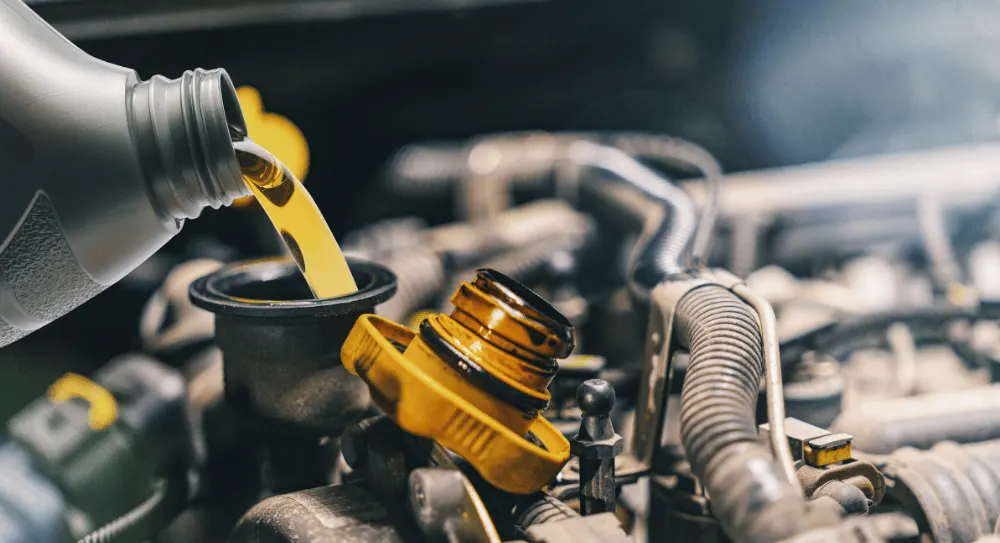Engine Oil 101: Understanding the Basics for Optimal Maintenance
By TOI Staff
June 19, 2023
Update on : June 19, 2023

When it comes to the health and performance of your engine, choosing the proper lubricant is crucial. It acts as a protective barrier, ensuring smooth operation, reducing friction, and preventing wear and tear. This article will look into the basics of engine oil, its essential functions, and how to maintain it for optimal engine performance.
The Importance of Oil
Engine oil serves several critical functions in your vehicle’s engine. It not only lubricates the moving parts but also plays a vital role in the following:
- Reducing Friction: It forms a thin film between moving parts, minimizing metal-to-metal contact and reducing friction, which can cause wear and damage.
- Cooling: It absorbs and dissipates heat generated during engine operation, preventing overheating and ensuring optimal operating temperatures.
- Cleaning: It carries away dirt, debris, and contaminants that can accumulate over time, helping to keep the engine clean and preventing the formation of harmful sludge.
- Seal Conditioning: It helps condition and maintains engine seals’ integrity, such as gaskets and O-rings, preventing oil leaks and proper compression.
- Corrosion Protection: It contains additives that protect engine components from corrosion and rust, prolonging their lifespan.
Oil Viscosity
Viscosity refers to the oil’s resistance to flow. It is indicated by the numbers on the oil container, such as 5W-30 or 10W-40. Understanding viscosity is crucial in selecting the right oil for your vehicle.
- The first number, followed by a “W” (e.g., 5W or 10W), represents the oil’s viscosity at low temperatures, indicating its ability to flow in cold conditions. The lower the number, the better the oil flows in cold weather.
- The second number (e.g., 30 or 40) represents the oil’s viscosity at high temperatures, indicating its ability to maintain proper lubrication and protection at high operating temperatures. Higher numbers indicate thicker oils that can withstand higher temperatures.
Choosing the Right Oil
Choosing the right oil involves considering factors such as:
Vehicle Manufacturer Recommendations
Always refer to your vehicle’s owner’s manual or consult the manufacturer’s recommendations to determine the recommended oil viscosity and specifications for your specific vehicle model.
Oil Certification
Look for engine oils that meet industry standards and certifications. The American Petroleum Institute (API) certification, such as API SN or API SP, indicates that the oil meets the required performance standards and specifications.
Synthetic vs. Conventional Oil
Car oils are available in both synthetic and conventional formulations. Synthetic oils are chemically engineered and offer superior performance and protection, especially in extreme temperatures and demanding conditions. Conventional lubricants, on the other hand, are more affordable. Consider your vehicle’s needs, manufacturer recommendations, and operating conditions when choosing synthetic and conventional oil.
Maintaining Engine Oil
Proper maintenance of oil is crucial for optimal engine performance and longevity. Here are some essential tips:
Regular Checks
Regularly check your oil level to ensure it is within the recommended range. This can be done by using the dipstick provided in the engine compartment. Low oil levels can result in insufficient lubrication and engine damage.
Routine Oil Changes
Regular oil changes are vital to maintaining clean and effective engine oil. Over time, car oil degrades and accumulates contaminants, reducing its effectiveness. Follow the manufacturer’s recommended oil change intervals based on mileage or time intervals.
Use Quality Filters
When performing an oil change, it is essential to use high-quality oil filters. Oil filters remove contaminants from the oil, preventing them from circulating through the car engine and causing damage. Replace the oil filter per the manufacturer’s recommendations during each oil change.
Proper Disposal
Dispose of used car oil responsibly. Take it to a certified recycling center or an authorized collection point. Never pour used oil down drains or onto the ground, as it harms the environment.
Monitoring Oil Condition
In addition to regular oil changes, monitoring the condition of your car oil is crucial. Consider the following indicators:
- Oil Color: Fresh car oil is typically amber or light brown. As it ages, the color may darken, indicating the presence of contaminants. The oil appearing excessively dark or milky may indicate engine issues, such as coolant leakage.
- Oil Consistency: The oil should have a smooth consistency. If you notice a gritty texture or the presence of metal particles, it may indicate internal engine wear or other problems. In such cases, it is advisable to consult a professional mechanic.
- Oil Consumption: Monitor the rate of oil consumption in your engine. If you notice a significant decrease in oil level between oil changes, it may indicate a leak or engine problem that requires attention.
Conclusion
Understanding the basics of car oil is crucial for optimal engine maintenance and performance. By selecting the right engine oil, following manufacturer recommendations, and practicing regular oil changes, you ensure proper lubrication, cooling, and protection for your engine. Give your engine the care it deserves with the right oil, and enjoy smooth and reliable performance mile after mile.
Read more: Engine Oil 101: Understanding the Basics for Optimal Maintenance















